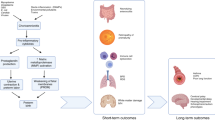Abstract
Objective:
Current American Academy of Pediatric recommendations call for the empirical use of antibiotics for all well-appearing term newborn infants born to women given a diagnosis of chorioamnionitis. The objective of this analysis was to determine among term infants (37–42 weeks gestation) the prevalence of exposure to clinical chorioamnionitis, intrapartum antibiotics, infant antibiotic use and neonatal intensive care unit (NICU) admission and the relationship of these risk factors to neonatal mortality.
Study Design:
United States-linked infant birth and death certificate files for the year 2008 were used. Maternal demographic variables, labor and delivery risk factors and infant characteristics were analyzed for associations with a reported diagnosis of chorioamnionitis and neonatal death, NICU admission and antibiotic usage.
Result:
There were 2 281 386 births available with information on the diagnosis of chorioamnionitis. The prevalence of chorioamnionitis in this population was 9.7 per 1000 live births (LB) and the neonatal mortality rate for exposed infants was 1.40/1000 LB vs 0.81/1000 LB for infants without chorioamnionitis, odds ratio (OR)=1.72, 95% confidence interval 1.20–2.45. The OR for neonatal death for infants with chorioamnionitis exposure who received antibiotics vs those who did not was 0.69 (95% confidence interval=0.21–2.26).
Conclusion:
Exposure to chorioamnionitis is associated with an increased risk of neonatal mortality. Guidelines for treatment of infants exposed to chorioamnionitis with antibiotics are followed in only a small proportion of such cases.
This is a preview of subscription content, access via your institution
Access options
Subscribe to this journal
Receive 12 print issues and online access
$259.00 per year
only $21.58 per issue
Buy this article
- Purchase on Springer Link
- Instant access to full article PDF
Prices may be subject to local taxes which are calculated during checkout
Similar content being viewed by others
References
Baker CJ, Byington Cl, Polin RA . Committee on Infectious Diseases; Committee on Fetus and Newborn Policy statement-recommendations for prevention of perinatal group B streptococcal (GBS) disease. Pediatrics 2011; 128 (3): 611–616.
Centers for Disease Control and Prevention Prevention of perinatal group B streptococcal disease – revised guidelines from CDC, 2010. MMWR Recomm Rep 2010; 59 (RR-10): 1–36.
Polin RA . Committee on Fetus and Newborn. Management of neonates with suspected or proven early-onset neonatal sepsis. Pediatrics 2012; 129 (5): 1006–1015.
Brady MT, Polin RA . Prevention and management of infants with suspected or proven neonatal sepsis. Pediatrics 2013; 132: 166–168.
Cotton MC, Smith B, Stoll BJ, Spitzer AR, Clark RH . Empirical antibiotic therapy for suspected early-onset bacterial sepsis. Pediatrics e-letter, published online 2012; 130 (4): e1052–e1053.
Puopolo KM . Response to the American Academy of Pediatris, Committee on the Fetus and Newborn statement, ‘Management of Neonates with Suspected or proven early-onset bacterial sepsis’. Pediatrics 2012; 130 (4): e1054–e1055.
Sukumar M . Need clarification on ‘abnormal labs’. Pediatrics 2012; 130 (4): e1055.
Taylor JA, Opel KJ . Choriophobia: a 1-act play. Pediatrics 2012; 130: 342–346.
National Center for Health Statistics 2003 Revisions of the U.S. Standard Certificates of Live Birth and Death and the Fetal Death Report. http://www.cdc.gov/nchs/nvss/vital_certificate_revisions.htm (last accessed 9/1/2013).
Osterman MJK, Martin JA, Mathews TJ, Hamilton BE . Expanded health data from the new birth certificate, 2008. Natl Vital Stat Rep 2011; 59 (7): 1–25.
National Center for Health Statistics. 2008 Linked Birth/Infant Death Period File http://www.cdc.gov/nchs/data_access/Vitalstatsonline.htm. Last accessed October 1, 2013.
Tita ATN, Andrews WW . Diagnosis and management of clinical chorioamnionitis. Clin Perinatol 2010; 37: 339–354.
Petrova A, Demissie K, Rhoads GG, Smulian JC, Marcella S, Ananth CV . Association of maternal fever during labor with neonatal and infant morbidity and mortality. Obstet Gynecol 2001; 98: 20–27.
Centers for Disease Control and Prevention. Prevention of perinatal group B streptococcal disease. a public health perspective. MMWR Recomm Rep 1996; 45 (RR_07): 1–24.
American Academy of Pediatrics Non-group A or B streptococcal and enterococcal infections. Red Book: 2003 Report of the Committee on Infectious Diseases. American Academy of Pediatrics Elk Grove Village, IL, USA, 2003. p590.
Puopolo KM, Draper D, Wi S, Newman TB, Zupancic J, Lieberman E et al. Estimating the probability of neonatal early-onset infection on the basis of maternal risk factors. Pediatrics 2011; 128: e1155–e1163.
Lieberman E, Lang J, Richardson DK, Frigoletto FD, Heffner LJ, Cohen A . Intrapartum maternal fever and neonatal outcome. Pediatrics 2000; 105: 8–13.
Mukhopadhyay S, Eichenwald EC, Puopolo KM . Neonatal early-onset sepsis evaluations among well-appearing infants: projected impact of changes in CDC GBS guidelines. J Perinatol 2013; 33: 198–205.
Acknowledgements
Michael H. Malloy: As the sole author of this manuscript, Dr Malloy conceptualized, designed, analyzed, drafted the initial manuscript and approved the final manuscript.
Author information
Authors and Affiliations
Corresponding author
Ethics declarations
Competing interests
The authors declare no conflict of interest.
Rights and permissions
About this article
Cite this article
Malloy, M. Chorioamnionitis: epidemiology of newborn management and outcome United States 2008. J Perinatol 34, 611–615 (2014). https://doi.org/10.1038/jp.2014.81
Received:
Revised:
Accepted:
Published:
Issue Date:
DOI: https://doi.org/10.1038/jp.2014.81
This article is cited by
-
Neonatal immune cells have heightened responses following in-utero exposure to chorioamnionitis or COVID-19
Pediatric Research (2023)
-
Placental clearance not synthesis tempers exaggerated pro-inflammatory cytokine response in neonates exposed to chorioamnionitis
Pediatric Research (2023)
-
Maternal and neonatal outcomes following magnesium sulfate in the setting of chorioamnionitis: a meta-analysis
Archives of Gynecology and Obstetrics (2023)
-
Separating the signal from the noise in metagenomic cell-free DNA sequencing
Microbiome (2020)
-
Interaction of chorioamnionitis at term with maternal, fetal and obstetrical factors as predictors of neonatal mortality: a population-based cohort study
BMC Pregnancy and Childbirth (2020)



